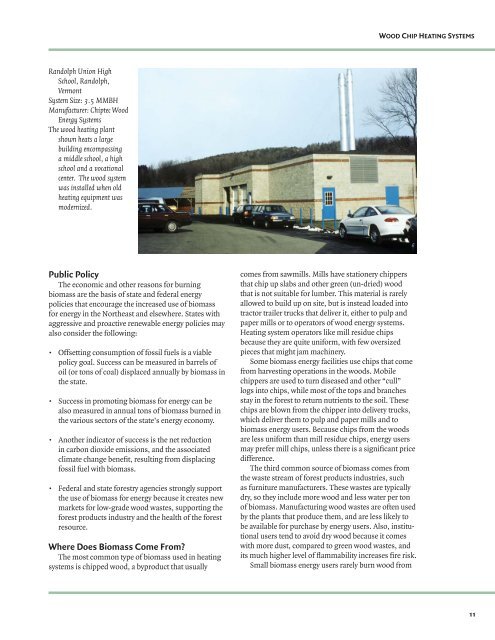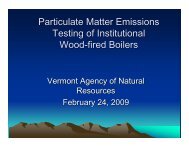Wood-Chip Heating Systems - Biomass Energy Resource Center
Wood-Chip Heating Systems - Biomass Energy Resource Center
Wood-Chip Heating Systems - Biomass Energy Resource Center
You also want an ePaper? Increase the reach of your titles
YUMPU automatically turns print PDFs into web optimized ePapers that Google loves.
Randolph Union High<br />
School, Randolph,<br />
Vermont<br />
System Size: 3.5 MMBH<br />
Manufacturer: <strong>Chip</strong>tec <strong>Wood</strong><br />
<strong>Energy</strong> <strong>Systems</strong><br />
The wood heating plant<br />
shown heats a large<br />
building encompassing<br />
a middle school, a high<br />
school and a vocational<br />
center. The wood system<br />
was installed when old<br />
heating equipment was<br />
modernized.<br />
Public Policy<br />
The economic and other reasons for burning<br />
biomass are the basis of state and federal energy<br />
policies that encourage the increased use of biomass<br />
for energy in the Northeast and elsewhere. States with<br />
aggressive and proactive renewable energy policies may<br />
also consider the following:<br />
• Offsetting consumption of fossil fuels is a viable<br />
policy goal. Success can be measured in barrels of<br />
oil (or tons of coal) displaced annually by biomass in<br />
the state.<br />
• Success in promoting biomass for energy can be<br />
also measured in annual tons of biomass burned in<br />
the various sectors of the state’s energy economy.<br />
• Another indicator of success is the net reduction<br />
in carbon dioxide emissions, and the associated<br />
climate change benefi t, resulting from displacing<br />
fossil fuel with biomass.<br />
• Federal and state forestry agencies strongly support<br />
the use of biomass for energy because it creates new<br />
markets for low-grade wood wastes, supporting the<br />
forest products industry and the health of the forest<br />
resource.<br />
Where Does <strong>Biomass</strong> Come From?<br />
The most common type of biomass used in heating<br />
systems is chipped wood, a byproduct that usually<br />
comes from sawmills. Mills have stationery chippers<br />
that chip up slabs and other green (un-dried) wood<br />
that is not suitable for lumber. This material is rarely<br />
allowed to build up on site, but is instead loaded into<br />
tractor trailer trucks that deliver it, either to pulp and<br />
paper mills or to operators of wood energy systems.<br />
<strong>Heating</strong> system operators like mill residue chips<br />
because they are quite uniform, with few oversized<br />
pieces that might jam machinery.<br />
Some biomass energy facilities use chips that come<br />
from harvesting operations in the woods. Mobile<br />
chippers are used to turn diseased and other “cull”<br />
logs into chips, while most of the tops and branches<br />
stay in the forest to return nutrients to the soil. These<br />
chips are blown from the chipper into delivery trucks,<br />
which deliver them to pulp and paper mills and to<br />
biomass energy users. Because chips from the woods<br />
are less uniform than mill residue chips, energy users<br />
may prefer mill chips, unless there is a signifi cant price<br />
difference.<br />
The third common source of biomass comes from<br />
the waste stream of forest products industries, such<br />
as furniture manufacturers. These wastes are typically<br />
dry, so they include more wood and less water per ton<br />
of biomass. Manufacturing wood wastes are often used<br />
by the plants that produce them, and are less likely to<br />
be available for purchase by energy users. Also, institutional<br />
users tend to avoid dry wood because it comes<br />
with more dust, compared to green wood wastes, and<br />
its much higher level of fl ammability increases fi re risk.<br />
Small biomass energy users rarely burn wood from<br />
WOOD CHIP HEATING SYSTEMS<br />
11





